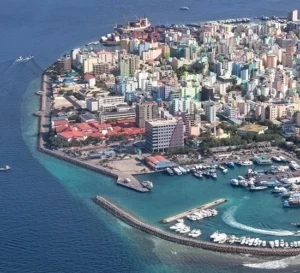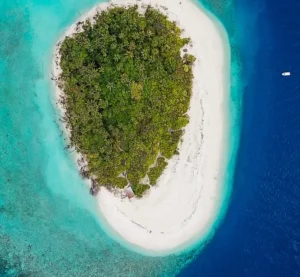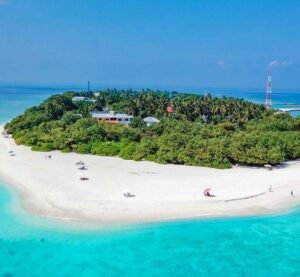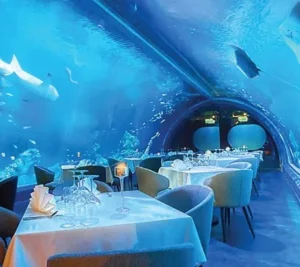Maldives
UTC+5 (Maldives Time)
No daylight saving time observed
Maldivian Rufiyaa (MVR)
Symbol: Rf or .ރ
US Dollars widely accepted at resorts and tourist areas
July 26, 1965 (from the United Kingdom)
Republic declared on November 11, 1968
National Day celebrated on first day of Rabeeul Awwal (Islamic calendar)
30-day tourist visa on arrival for all nationalities
No pre-arrival visa application required
Proof of accommodation and sufficient funds may be requested
Culture
Maldivian culture has been shaped by its island geography, maritime history, and influences from across the Indian Ocean. As a nation of nearly 1,200 islands spread over 90,000 square kilometers of ocean, the Maldives has developed distinct traditions that blend South Asian, Arab, and African elements with its own unique island character.
Key elements of Maldivian culture include:
- Religion: Islam is the state religion and a central aspect of Maldivian identity. The country converted to Islam in 1153 CE, and today virtually all Maldivians are Sunni Muslims. Islamic traditions influence daily life, architecture, celebrations, and laws. Mosques are prominent features on almost every inhabited island.
- Language: Dhivehi is the national language, written in Thaana script which reads from right to left. This unique language is related to Sinhala (spoken in Sri Lanka) but has been influenced by Arabic, Hindi, and English. While English is widely spoken in tourist areas and by government officials, Dhivehi remains vital to cultural identity.
- Traditional arts: Maldivian crafts include lacquer work (liyelaa jehun), mat weaving (thundu kunaa), boat building, and intricate coral carvings that once adorned mosques. The lacquer work, with its distinctive red, black, and yellow designs on wooden objects, is particularly emblematic of local craftsmanship.
- Music and dance: Traditional Maldivian music features the boduberu ("big drum"), a large drum made from coconut wood covered with goat hide. Boduberu performances involve rhythmic drumming that gradually increases in tempo, accompanied by dancing and singing. These performances often tell stories of island life and history.
Maritime traditions run deep in Maldivian culture, with fishing playing a central role in both economy and identity. The traditional fishing vessel, the dhoni, has evolved from a sail-powered boat to a modern motorized vessel but retains its distinctive shape. Fishing methods, particularly pole-and-line tuna fishing, have been passed down through generations and are practiced in environmentally sustainable ways.
Maldivian cuisine reflects the country's island environment and historical trade connections:
- Staples: Fish (especially tuna), coconut, and rice form the foundation of most meals
- Mas huni: A breakfast dish made of shredded smoked tuna, grated coconut, onion, and chili
- Garudhiya: A clear fish broth served with rice, lime, chili, and onions
- Hedhikaa: Savory snacks like bajiya (fish-stuffed pastries), gulha (fish-filled dumplings), and keemia (fried fish rolls)
- Flavors: Subtle use of curry leaves, cardamom, cinnamon, ginger, and coconut, creating a cuisine distinct from but influenced by Indian and Sri Lankan foods
Modern Maldivian culture balances traditional island life with contemporary global influences. While tourism has brought significant changes, particularly to islands developed as resorts, community islands maintain many traditional practices. Family ties remain strong, and the sense of community is reinforced through collective activities and celebrations. Islamic holidays, particularly Eid, are celebrated nationwide, while Republic Day (November 11) and Independence Day (July 26) mark important national occasions.
Tourism & Best Sites to Visit
The Maldives has established itself as one of the world's premier luxury travel destinations, famed for its pristine beaches, crystal-clear waters, and exclusive resort experiences. The country's unique "one island, one resort" concept offers unparalleled privacy and immersion in tropical island beauty.
Here are some of the Maldives' most remarkable experiences:





Overwater Villas: Perhaps the most iconic Maldivian experience, these luxurious accommodations perched above turquoise lagoons offer direct access to the ocean, often featuring glass floors, private pools, and uninterrupted horizon views. Top resorts like Soneva Jani, Conrad Maldives, and Gili Lankanfushi have elevated this concept to an art form.
Malé: The compact capital city provides a fascinating contrast to the resort islands, with its colorful buildings, bustling markets, and cultural landmarks. Highlights include the 17th-century Old Friday Mosque (Hukuru Miskiy) with its intricate coral stone carvings, the Islamic Centre with its golden dome, the vibrant local market, and the National Museum housing historical artifacts.
Hanifaru Bay: From May to November, this marine protected area in Baa Atoll (a UNESCO Biosphere Reserve) becomes a feeding ground for manta rays and whale sharks. Witnessing dozens of these gentle giants filter-feeding in the bay is considered one of the world's most spectacular marine encounters.
Local Islands: Islands like Maafushi, Dhiffushi, and Thulusdhoo offer a glimpse into everyday Maldivian life and more affordable accommodation options. Recent changes in regulations have allowed guesthouses on inhabited islands, opening up the Maldives to budget-conscious travelers while providing cultural experiences beyond the resort bubble.
Underwater Restaurant: Ithaa at Conrad Maldives Rangali Island was the world's first all-glass undersea restaurant, situated 5 meters below the ocean surface. Dining surrounded by coral reefs and marine life offers a unique perspective on the Maldives' renowned underwater world.
The Maldives is also a premier destination for water activities including snorkeling, scuba diving, surfing (particularly in the North and South Malé Atolls), dolphin watching, fishing excursions, and sailing on traditional dhonis. For wellness enthusiasts, many resorts feature world-class spas, often with treatment rooms overlooking the ocean or glass floors revealing marine life below.
Transportation
The Maldives' geography as a nation of nearly 1,200 islands spread across 90,000 square kilometers of ocean creates unique transportation challenges and experiences. Getting between islands typically involves boats, seaplanes, or domestic flights, with each option offering different perspectives on the country's stunning seascapes.
- Seaplanes: A quintessential Maldivian travel experience, these aircraft provide spectacular aerial views of the atolls. Trans Maldivian Airways operates the world's largest seaplane fleet, primarily serving resort islands. Seaplanes only operate during daylight hours (typically 6 AM to 6 PM) and fly to resorts located more than 50 kilometers from Malé. The 15-50 minute flights, while expensive, offer breathtaking photo opportunities of the islands and reefs below.
- Speedboats: The most common transfer method for resorts closer to Malé (within about 50 kilometers). These fast boats typically take 15-90 minutes depending on distance and can operate in most weather conditions and at night. Resorts arrange these transfers, which are usually shared with other guests arriving on the same flight.
- Public ferries: An affordable option for traveling between Malé and local inhabited islands. The public ferry network connects many islands, though services can be infrequent (often just 1-2 times per week to outlying atolls) and schedules may change based on weather conditions. These ferries offer an authentic local experience but require flexibility in your schedule.
- Domestic flights: Operated by Maldivian and Villa Air (Flyme), these connect Malé with regional airports on larger islands throughout the atolls. After landing at these domestic airports, travelers typically transfer to their final destination by speedboat. This combined air-sea option is common for reaching resorts in distant atolls when seaplane service isn't available.
- Dhoni: The traditional Maldivian wooden boat, now often motorized, remains an important mode of transportation between nearby islands. Some resorts offer dhoni excursions as a cultural experience, and these vessels are frequently used for fishing trips and island-hopping tours.
Transportation within islands: Most resort islands are small enough to walk around (typically 15-45 minutes to circumnavigate), though many provide bicycles or golf carts for guests. On larger inhabited islands, taxis, motorcycles, and bicycles are common, while Malé also has public buses that circle the island.
Important considerations:
- Transfer costs: Transportation between the airport and resorts is an additional expense that can be substantial (particularly for seaplanes), so factor this into your budget
- Timing: Plan your international flights with transfer hours in mind, especially if taking seaplanes (which only operate during daylight) or public ferries (which run on limited schedules)
- Luggage restrictions: Seaplanes and domestic flights have strict weight limitations (typically 20-25kg per person), with extra charges for excess baggage
- Weather impacts: During rough weather, boat transfers may be delayed or canceled for safety reasons
When planning your Maldives itinerary, consider the transportation logistics between islands if you wish to visit multiple destinations. Many travelers choose to stay at just one resort due to the time and expense involved in island-hopping. For those wanting to explore multiple islands, choosing locations within the same atoll or region can minimize transfer times and costs.
Airports
The Maldives has several airports connecting the archipelago both internationally and domestically. These transportation hubs are crucial for tourism and for connecting the widely dispersed island communities.
- Velana International Airport (MLE): Formerly known as Ibrahim Nasir International Airport, this is the main gateway to the Maldives, located on Hulhulé Island adjacent to Malé. The airport has seen significant modernization in recent years, including a new runway capable of handling large aircraft and an expanded international terminal. It serves numerous international airlines with direct flights from Europe, Middle East, and Asia. The airport features restaurants, duty-free shopping, lounges, and currency exchange services. A bridge connects the airport island to Malé, making transfers to the capital easy.
- Gan International Airport (GAN): Located in the southern Addu Atoll, this is the Maldives' second international airport. Originally built as a British Royal Air Force base, it now serves as an important gateway to the southern atolls. International flights are primarily regional connections, though some seasonal charter flights operate from Europe. The airport has been developed to encourage tourism growth in the southern Maldives.
-
Domestic airports: Several domestic airports serve various atolls throughout the country, including:
- Hanimaadhoo Airport (HAQ) – serving the northern atolls
- Dharavandhoo Airport (DRV) – serving Baa Atoll
- Maamigili Airport (VAM) – serving Ari Atoll
- Kaadedhdhoo Airport (KDM) – serving Gaafu Dhaalu Atoll
- Kooddoo Airport (GKK) – serving Gaafu Alifu Atoll
- Several others serving different regions of the country
- Seaplane terminals: Velana International Airport also houses the seaplane terminals for Trans Maldivian Airways and Maldivian, which operate flights directly to resort islands. These terminals are separate from the main international terminal and have their own lounges for passengers awaiting transfers.
Airport Transportation: Options for reaching your destination from airports include:
- Resort transfers: Most resorts organize transfers for their guests directly from the airport. When booking your accommodation, the resort will request your flight details to arrange appropriate transportation.
- Ferry to Malé: From Velana International Airport, public ferries run frequently (approximately every 10-15 minutes) to Malé. The journey takes about 10 minutes and costs a nominal fee. The ferry terminal is a short walk from the airport arrival area.
- Taxis: Available at domestic airports to transfer to nearby guesthouses or ferry terminals.
- Speedboats: Available for hire at most airports for private transfers, though this is an expensive option.
Important notes: When arriving in the Maldives, all tourists must have confirmed accommodation for their entire stay. Immigration officers may ask for details of your resort or hotel booking. For international departures, it's advisable to arrive at Velana International Airport at least 3 hours before your flight, as check-in and immigration procedures can be time-consuming during peak tourist season.
Visa & Travel Information
The Maldives has a straightforward entry policy designed to facilitate tourism, which forms the backbone of the country's economy. The visa process is simple for most visitors, though certain regulations related to the country's Islamic customs should be understood before traveling.
Visa Information
The Maldives offers one of the world's most welcoming visa policies:
| Nationality | Visa Type | Duration |
|---|---|---|
| All Nationalities | Visa on Arrival | 30 days |
Requirements for visa on arrival:
- Passport valid for at least 6 months from date of entry
- Confirmed accommodation reservation for your entire stay
- Proof of sufficient funds (rarely checked for tourists)
- Confirmed return/onward ticket
- Completed Traveller Declaration form (usually provided during your flight or available online)
There is no visa fee for the standard 30-day tourist visa. Extensions for up to an additional 60 days (90 days total) can be obtained from the Maldives Immigration Department in Malé for a fee, provided you still meet the entry requirements.
Important Travel Considerations
- Customs regulations: As an Islamic country, the Maldives prohibits the importation of alcohol, pork products, religious materials contrary to Islam, pornography, idols of worship, and narcotics. Alcohol is available only at tourist resorts and liveaboard boats, not on local inhabited islands.
- Health: No specific vaccinations are required for entry, though standard travel immunizations are recommended. The Maldives has good medical facilities at resort islands and in Malé, but serious medical emergencies may require evacuation to neighboring countries. Comprehensive travel insurance with medical coverage is strongly advised.
- Cultural sensitivities: When visiting inhabited local islands (not resort islands), appropriate dress is required - shoulders and knees should be covered for both men and women. Public displays of affection are frowned upon. During Ramadan, eating, drinking, or smoking in public on local islands during daylight hours should be avoided out of respect.
- Environmental considerations: The Maldives' fragile marine ecosystem is vulnerable to climate change and human impact. Many resorts have marine biologists and conservation programs. As a visitor, avoid touching coral, do not remove shells or marine life, and use reef-safe sunscreen.
Best time to visit: The Maldives enjoys a tropical climate year-round:
- Dry season (November to April): The peak tourist season with less rainfall, lower humidity, and excellent visibility for snorkeling and diving. December to March sees the highest prices and occupancy.
- Wet season (May to October): Characterized by brief but intense rain showers, higher humidity, and occasionally rougher seas. This period offers better value, fewer crowds, and still plenty of sunshine between showers. May to August is popular with surfers due to larger swells.
- Water temperature: Remains a pleasant 26-29°C (79-84°F) year-round, making water activities enjoyable regardless of season.
Money matters: While the local currency is the Maldivian Rufiyaa (MVR), US dollars are widely accepted (and often preferred) at resorts, airports, and tourist areas. Credit cards are accepted at resorts and upscale establishments, though smaller guesthouses on local islands may prefer cash. ATMs are available in Malé and at the airport, but limited elsewhere. Most resorts operate on a cashless system where expenses are charged to your room and settled upon checkout.
Connectivity: Mobile coverage is good throughout the inhabited islands, and most resorts offer Wi-Fi (sometimes for an additional fee). Local SIM cards are available at the airport for those needing continuous connection. The country code for the Maldives is +960.